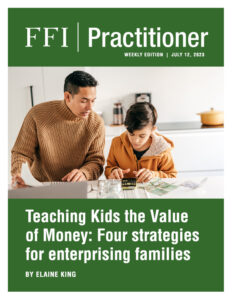
View this edition in our enhanced digital edition format with supporting visual insight and information.
Thank you to Elaine King, this week’s contributor, for her article that provides a model for educating younger next gen family members about financial skills and practices. This article can be a useful conversation starter with clients, especially earlier generation families who utilize the concept of an “allowance” with their younger children. Although Elaine uses US dollars to illustrate her concepts on financial literacy, her suggestions can apply to any currency. For other ideas on this topic, please see the related articles section at the end of the article.
No one is born a financial expert. Financial concepts are learned, sometimes from a very early age, but often later in life, if at all. Although many children learn financial skills and practices from their parents, often the parental example may not include financial best practices. In many cases, children do not learn the basic knowledge and essential skills associated with effective financial management at all, yet teaching financial literacy to the next generation of wealth owners is one of the most critical aspects of sustaining your enterprising family clients’ wealth over generations!
In our practice of advising wealthy families, we have found some simple ways to help educate younger family members about the basics of sound money management. These skills, when learned from an early age, can help foster successful wealth transfer between generations and responsible financial behavior.
First, we begin by addressing the goal of growing the family wealth, which is represented by more than a number on a balance sheet. It includes the human, intellectual, social, and financial capital held by a family. Teaching financial responsibility enhances all of these forms of capital.
A useful strategy is to apply a methodology to distribute a child’s allowance before spending it, classifying it into four categories:
- SPEND
- SAVE
- GROW
- SHARE
The allowance a child receives could be earned by a combination of task completion and positive reinforcement. There are four useful practices that can be implemented in any family to engage young family members, encouraging responsible financial practice from the beginning, and strengthening the cognitive connection between a family and its wealth. These basic practices are easy to do consistently, and continuous, daily practice at home helps to reinforce the concepts.
Practice #1: Teach the Value of a Dollar and Delayed Gratification
According to studies on impulsivity1, we are born with an inherent urge to react without considering long-term consequences, so it’s necessary to explain to children that patience pays off by explaining delayed gratification. It is also important to learn how to earn money in order to truly know its value. Here are some creative ways to teach value and delayed gratification:
Learning Opportunity:
- Compare the difference between desire and need. Parents and children can walk around the house and categorize the items inside: was this a “need” or a “want”? Identifying the difference helps children understand the family doesn’t need everything it has.
- Establish a basic allowance system for accomplishing specific tasks. When children receive their allowance, take them to the store to allow them to help with household purchases or purchase their own lunch. This will demonstrate the challenge between earning and spending.
- When a child asks for something, teach him or her the concept of waiting by delaying fulfillment of the request for a short period. For larger asks encourage waiting for more time to teach delayed gratification.
Practice #2: The Importance of Having Clear Savings Goals
To be effective, savings should have a clear goal and be measurable, attainable, realistic, and specific, with a determined timeframe. Families can teach children that saving should come before spending with an assigned percentage such as 10 or 25 percent. Saving as little as $2.70 per day amount to almost $1,000 in a year.
Learning Opportunity:
- Work together and prepare a list of various forms of income from the children’s perspective: allowance, extra housework, gifts, etc. Next, prepare a list of all their expenditures, including snacks, games, toys, and activities. If the difference between income and expenditure results is positive, consider a “match” to positively reinforce; if the result is negative, consider a “loan” with some degree of interest.
- Families can work with their children to establish clear savings goals. Once those goals are established, consider some incentive for meeting the goals, such as matching the savings.
Practice #3: The Difference Between Saving and Investing
The number one enemy of savings is debt. However, it is important to understand that there is positive debt, which gains value over time (e.g., a business loan). By saving a little at a time and investing wisely, money can grow significantly with compound interest. Convey the message, “Put your money to work!”
Learning Opportunity:
Buy a share of stock that children are familiar with, such as Apple or Disney. Have each family member pick up a different company and after a certain period of time (month, quarter, year), share and compare the results in terms of market value and performance.
Practice #4: The Exponential Effect of Sharing
Protecting the family’s money is critical to sustaining wealth, but just as critical is giving back. Sharing time and resources with the community proves an invaluable experience for young family members, because it demonstrates the positive impact wealth can have on the community at large, rather than just themselves.
Learning Opportunity:
- A family can decide on a philanthropic mission or purpose and encourage the children to identify ways they can contribute to the cause.
- Discuss and establish a percentage of the family income that will be dedicated to philanthropy. When the children receive money, they can dedicate a portion to savings, a portion to spending, a portion to investing, and a portion to philanthropy, so they can begin to understand how to maximize the money they receive.
The bottom line is that the family’s example will shape children’s attitudes and behaviors towards money, as well as their ultimate spending habits.2 The legacy a family leaves behind will be continued through its children. Plan it carefully.
References
1 Daruna, J. H.; Barnes, P. A. (1993). “A neurodevelopmental view of impulsivity”. In McCown, William George; Johnson, Judith L.; Shure, Myrna B. (eds.). The Impulsive Client: Theory, Research, and Treatment. Washington, DC: American Psychological Association. pp. 23–37. doi:10.1037/10500-002. ISBN 978-1-55798-208-7.
2 “Survey Finds 93% of Teens Believe Financial Knowledge and Skills Are Needed to Achieve Their Life Goals”. Greenlight Financial Technology. 2022. https://www.businesswire.com/news/home/20220404005339/en/Survey-Finds-93-of-Teens-Believe-Financial-Knowledge-and-Skills-Are-Needed-to-Achieve-Their-Life-Goals
About the Contributor

Elaine King, ACFBA, CFP® is the founder of Family and Money Matters™, with the mission of empowering the family’s financial and human capital to achieve financial wellbeing. She has served as the Family’s Financial Planner for over 1,200 families and 100 multigenerational family enterprises crafting actionable family financial plans. Elaine created the first family financial program in LATAM and was awarded the Best Latin book award for her book, “Family and Money Matters – Next Generation“. She was recognized in 2020 in the list of Investopedia‘s Top Influential Advisors and in 2017 recognized by People Magazine’s Top 25 Influential Hispanic Women. Elaine has been featured in the WSJ, Forbes, Telemundo, and CNN and is a columnist for financial journals in the US and LATAM. She can be reached at elaine@familyandmoneymatters.com.

View this edition in our enhanced digital edition format with supporting visual insight and information.




